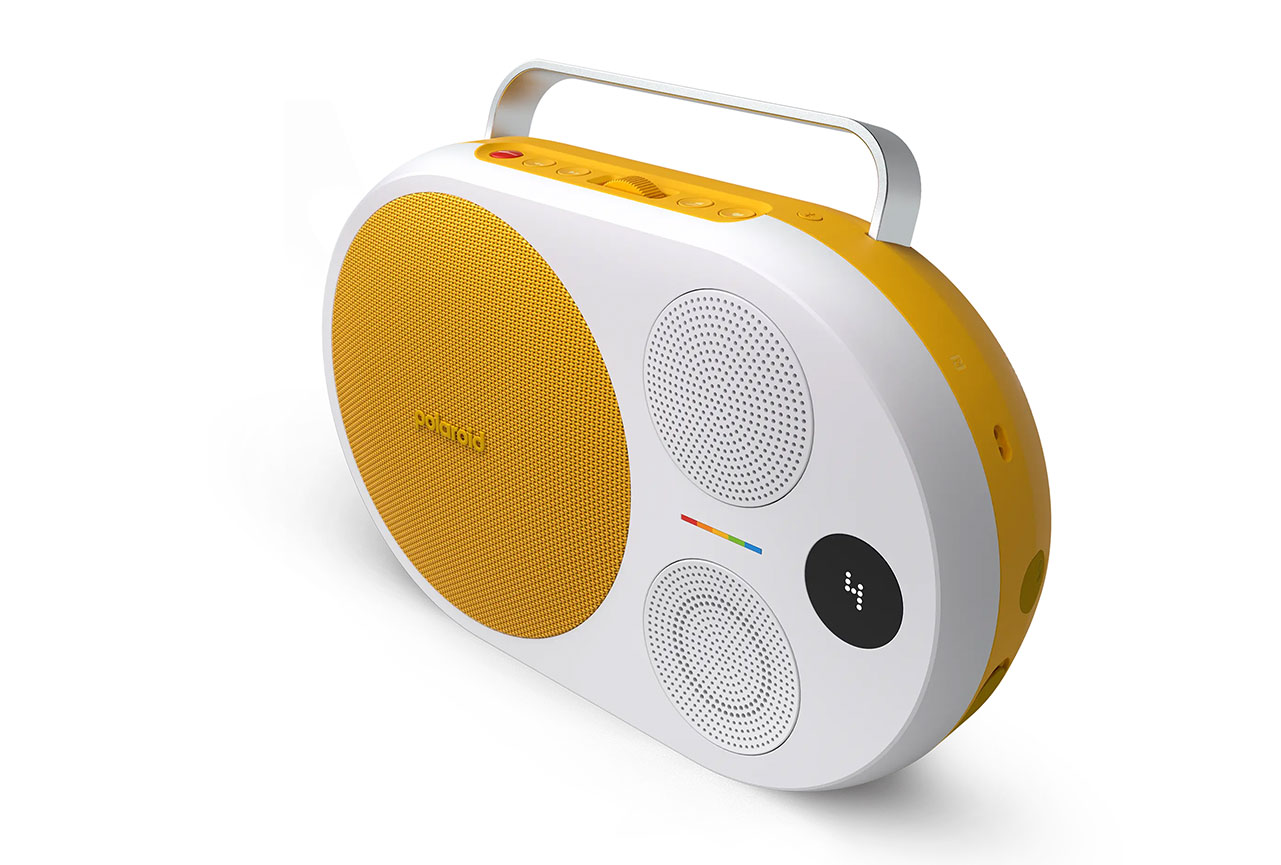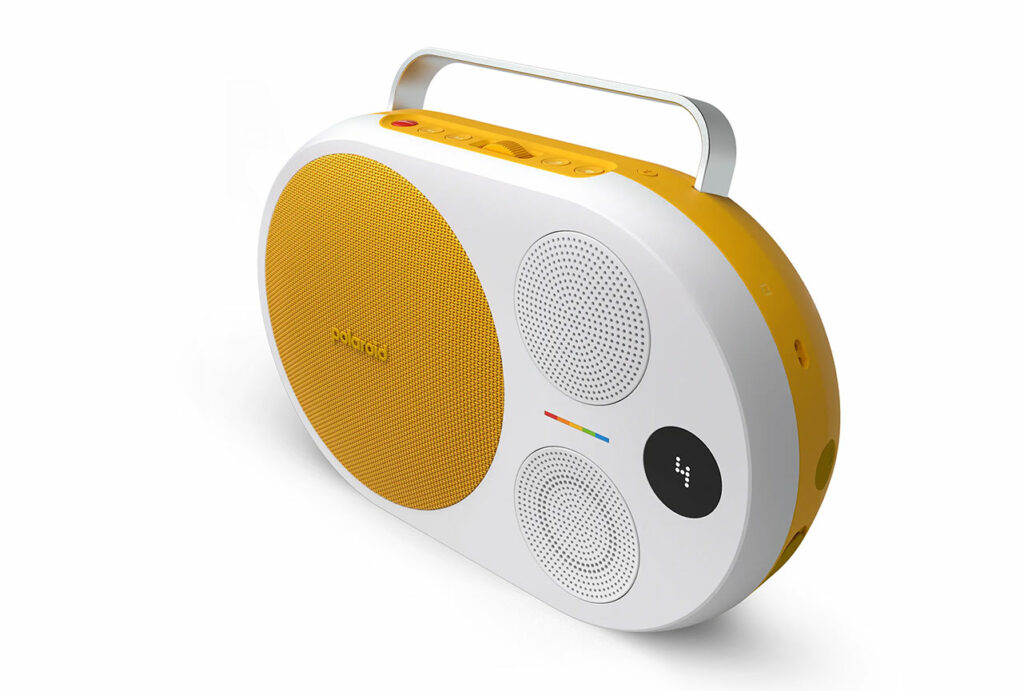We put the Polaroid P4 Bluetooth Speaker through our rigorous DXOMARK Audio test suite to measure its performance at playing back audio. In this review, we will break down how it fared in a variety of tests and several common use cases.
Overview
Key specifications include:
- Wireless protocols : Bluetooth
- Wired connectivity : Jack
- Height: 32.2 cm. Width: 39.5 cm. Depth: 14.0 cm
- Weight : 2680g
- Speaker: ≥ 75dB (A), 60Hz-20KHz
Test conditions:
- Tested with Motorola G8
- Communication protocol used: Bluetooth
 Polaroid P4 Bluetooth Speaker
Polaroid P4 Bluetooth Speaker


Pros
- Good timbre performance at maximum volume
- Pretty snappy attack
Cons
- Harsh treble
- Lack of low-end and low midrange
- Excessive compression
In our DXOMARK Speaker test, the Polaroid P4 delivered a surprisingly good performance at maximum volume. In combination with the pretty loud maximum volume level this makes it a good option for use at outdoor parties and similar occasions, despite some limitations such as excessively harsh and aggressive treble, as well as high levels of compression across all volume levels, which had a negative impact on the listening experience.
Listen to the tested speaker’s playback performance in this comparison with its competitors:
Test summary
About DXOMARK Wireless Speaker tests: For scoring and analysis in our wireless speaker reviews, DXOMARK engineers perform a variety of objective tests and undertake more than 20 hours of perceptual evaluation under controlled lab conditions. This article highlights the most important results of our testing. Note that we evaluate playback using only the device’s built-in hardware. (For more details about our Speaker protocol, click here.)
The following section gathers key elements of our exhaustive tests and analyses performed in DXOMARK laboratories. Detailed performance evaluations under the form of reports are available upon request. Do not hesitate to contact us.
The DXOMARK Speaker overall score is derived from a range of sub-scores. In this section, we will take a closer look at timbre, dynamics, spatial, volume, and artifacts, and explain what they mean for the user.

Timbre
Polaroid P4 Bluetooth Speaker
152
DXOMARK timbre tests measure how well a speaker reproduces sound across the audible tonal range and takes into account bass, midrange, treble, tonal balance, and volume dependency.
In our tests, Polaroid’s P4 speaker delivered a very bright but thin tonal balance, with an upper treble that sounded a bit harsh and even slightly resonant on some tracks. Looking at the frequency response graph, multiple notches can be seen in the upper spectrum, inducing an inconsistent treble rendition for the listener. Treble was however far less problematic in vocal-centric use cases, for example, when watching movies or listening to podcasts. Additionally, treble was less aggressive at a lower volume — at the expense of bass.
Midrange also sounded a bit thin and inconsistent. Our experts noticed a lack of clarity from upper midrange, which induced blurriness. Conversely, low midrange was also deemed slightly insufficient; especially at low volume. This lack of body is emphasized by the low-end of the spectrum, which lacked strength a lot.
All in all, timbre didn’t allow for a consistent rendition of musical content, especially in regard to mix fidelity. The tonal balance was more enjoyable at maximum volume (despite the harshness), but movies and podcasts were indubitably the best suited use cases to offset the drawbacks mentioned.

Dynamics
Polaroid P4 Bluetooth Speaker
137
Our dynamics tests measure how well a device reproduces the energy level of a sound source, taking into account attack, bass precision, and punch.
Results for the dynamics performance were slightly below average for the Polaroid P4. Most importantly, excessive compression was observed during perceptual evaluation (see artifacts section for more details). This had a detrimental impact on envelope accuracy. Attack was pretty snappy in most use cases but was held back by distortion, which impaired transients. Fairly frequent overshoots made attack of the bass notes stand out too much from the sustain, which was naturally weak due to an inherent lack of low-end. This resulted in a less convincing bass precision performance. Punch was severely impaired by the excessive compression as well, in addition to a lack of low midrange and low end support.

Spatial
Polaroid P4 Bluetooth Speaker
111
Our spatial tests measure a speaker’s ability to reproduce stereo sound in all directions, taking into account localizability, balance, wideness, distance, and directivity. Please note that wideness is 0 on mono speakers and on speakers that cannot deliver a significant stereo effect.
The speaker has interesting properties in terms of directivity, as it is front-firing but with an asymmetrical design and an open back. Upper frequencies were especially directive according to our measurements, meaning the Polaroid P4 would sound noticeably less bright when listening from the sides or the rear. Given the aforementioned harshness of treble, this would not necessarily be a bad thing, at least in perceptual evaluation. However, despite midrange being more consistent around the speaker, this also means tonal balance would differ a lot depending on where the listener is situated, which ultimately holds back the potential use for parties or gatherings.
The speaker is essentially monophonic and the asymmetrical design resulted in audio sometimes being slightly off-centered. Localizability of individual sound sources in the scene was blurry across most use cases. Distance rendition was decent but not perfectly realistic when compared to other speakers in this class, as voices could sound a bit too close due to the upper treble emphasis.

Volume
Polaroid P4 Bluetooth Speaker
141
Our volume tests measure both the maximum loudness a speaker is able to produce and how smoothly volume increases and decreases based on user input.
Volume performance was pretty good, with a satisfying loudness maximum volume and a pretty consistent volume-step distribution. This said, the volume curve could have been smoother, with the first few steps being quite steep.
Here are a few sound pressure levels (SPL) we measured when playing our sample recordings of hip-hop and classical music at maximum volume:
| Correlated Pink Noise | Uncorrelated Pink Noise | Hip-Hop | Classical | Latin | Asian Pop | |
| Polaroid P4 Bluetooth Speaker | 91.1 dBA | 88.8 dBA | 85.6 dBA | 78.4 dBA | 86.6 dBA | 79.2 dBA |
| Sonos Era 100 | 87.2 dBA | 85 dBA | 81.7 dBA | 76.2 dBA | 84.9 dBA | 75.4 dBA |
| Sony SRS-XG300 | 88.9 dBA | 85.9 dBA | 85 dBA | 79.2 dBA | 85.9 dBA | 79.9 dBA |

Artifacts
Polaroid P4 Bluetooth Speaker
133
Our artifacts tests measure how much source audio is distorted when played back, along with such other sound artifacts as noise, pumping effects, and clipping. Distortion and other artifacts can occur both because of sound processing and because of the quality of the speakers.
Compression was the most noticeable audio artifact on the P4. It induced overshoots and pumping at nominal volume and louder. Distortion was noticeable in treble frequencies at nominal volume, as it can be seen on the THD graph. Our experts also noticed bass distortion at maximum volume, for example when playing music at a party or similar use cases.
The metallic back grid can resonate when excited by certain frequencies at loud volume.



DXOMARK encourages its readers to share comments on the articles. To read or post comments, Disqus cookies are required. Change your Cookies Preferences and read more about our Comment Policy.